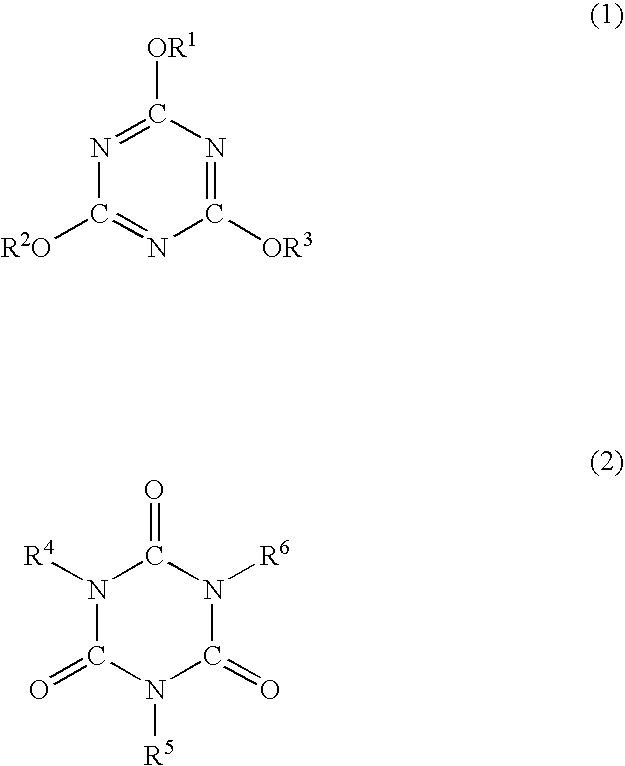Flame-retardant polyamide resin composition and extrusion-molded product
a technology resin composition, which is applied in the field of flame retardant polyamide resin composition and extrusion molding product, can solve the problems of remarkable mechanical strength deterioration, poor workability and safety, and difficult to impart good flame retardancy to the polyolefin, and achieve excellent flame retardancy, flexibility, mechanical strength and heat resistance. , the effect of excellent flame retardancy
- Summary
- Abstract
- Description
- Claims
- Application Information
AI Technical Summary
Benefits of technology
Problems solved by technology
Method used
Image
Examples
reference example 1
[0073] A 200 L autoclave was charged with 60 kg of caprolactam and 200 mL of water, purged with a nitrogen gas and then closed. After heating the contents of the autoclave to 150° C., a 40% hexamethylene diammonium adipate aqueous solution previously prepared so as to have a predetermined composition was fed into the autoclave by a metering pump while maintaining an inside temperature and inside pressure of the autoclave at 150° C. and 2.5 kg, respectively, under stirring. After completion of the feeding, the inside temperature of the autoclave was raised to 260° C. while maintaining the inside pressure thereof at 10 kg. After completion of the temperature rise, the inside pressure of the autoclave was released, and the contents of the autoclave were reacted with each other under reduced pressure until reaching a desired stirring power. After introducing a nitrogen gas into the autoclave to retain the inside pressure at ordinary pressure, the stirring operation was stopped, and the ...
reference example 2
[0074] A 200 L autoclave was charged with 60 kg of caprolactam and 200 mL of water, purged with a nitrogen gas and then closed. After heating the contents of the autoclave to 150° C., a 40% hexamethylene diammonium azelate aqueous solution previously prepared so as to have a predetermined composition was fed into the autoclave by a metering pump while maintaining an inside temperature and inside pressure of the autoclave at 150° C. and 2.5 kg, respectively, under stirring. After completion of the feeding, the inside temperature of the autoclave was raised to 260° C. while maintaining the inside pressure thereof at 10 kg. After completion of the temperature rise, the inside pressure of the autoclave was released, and the contents of the autoclave were reacted with each other under reduced pressure until reaching a desired stirring power. After introducing a nitrogen gas into the autoclave to retain the inside pressure at ordinary pressure, the stirring operation was stopped, and the ...
examples 4 to 9
[0085] 98 parts by weight of a polyamide resin mixture composed of 46.7 parts by weight of the polyamide resin E, 43.2 parts by weight of the polyamide resin C and 8.1 parts by weight of the polyamide resin D (weight ratio between constituting units: 6 units / 66 units / 69 units=87.3 / 8.6 / 4.1) was blended with 2 parts by weight of the triazine-based flame retardant as well as various stabilizers in amounts as shown in Table 2, and the resultant mixture was melted, kneaded and then pelletized by the same method as defined in Example 1, thereby obtaining pellets of a polyamide resin composition. The thus obtained polyamide resin composition pellets were formed into the above tensile test specimen. The obtained test specimen in a dried state was subjected to a tensile test to measure initial properties thereof. Next, the tensile test specimen was subjected to heat treatment (heat-aging treatment) in a hot-air circulating type oven at 165° C. for 168 hours. The thus heat-treated test specim...
PUM
| Property | Measurement | Unit |
|---|---|---|
| Percent by mass | aaaaa | aaaaa |
| Percent by mass | aaaaa | aaaaa |
| Percent by mass | aaaaa | aaaaa |
Abstract
Description
Claims
Application Information
 Login to View More
Login to View More - R&D
- Intellectual Property
- Life Sciences
- Materials
- Tech Scout
- Unparalleled Data Quality
- Higher Quality Content
- 60% Fewer Hallucinations
Browse by: Latest US Patents, China's latest patents, Technical Efficacy Thesaurus, Application Domain, Technology Topic, Popular Technical Reports.
© 2025 PatSnap. All rights reserved.Legal|Privacy policy|Modern Slavery Act Transparency Statement|Sitemap|About US| Contact US: help@patsnap.com


